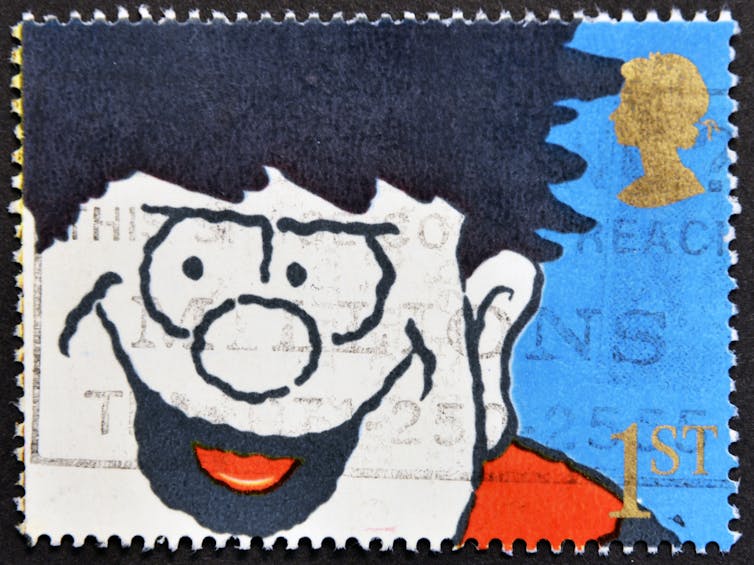Dennis the Menace lives on: the influence of this 70-year-old on everything from darts to raves
The current Somerset House exhibition in London, Beano: The Art of Breaking the Rules, revels in the joyful impudence of the 83-year-old comic magazine’s characters. A tribute to the publication’s impact seems long overdue; as curator Andy Holden says: “Beano’s irreverent sensibility is something that appeals to you as a child, but also, for some, never leaves you.”
The Beano plays an important role in children’s lives because, along with other Beano readers, you become part of a community, through the readers’ letters page, fan art and fan club.
Beano’s longevity can be attributed to what educator Carol Tilley calls the “participatory culture” of comics and its diversity of characters.
Of all the Beano’s characters, no one better exemplifies the essence of sheer impertinence and anarchic subversiveness - as represented in the exhibition’s title - than Dennis the Menace himself.
Indeed, the 70-year-old character has helped maintain the Beano as a long-running publication. Dennis debuted in a black-and-white half-pager tucked inside the issue of March 17 1951. From that pivotal moment, growing demand for Dennis’s adventures “led him to the colour back cover in 1954 … and then to the cover replacing Biffo the Bear”.
I first discovered Dennis when he was 20 years old, and I was all of eight. In December 1971, I was growing up in Quebec, Canada, and my UK grandparents sent me the 1972 Beano Book as a Christmas present. Dennis was introduced as a large red and black drawing that depicted him shaving his name into his dog Gnasher’s fur. As Beano characters often do, Dennis broke the fourth wall, gazing beyond the page. I immediately identified with this cheeky chap.
Cultural impact
Journalist David Mapstone observes that, until recently, the UK’s weekly printed comics, such as Beano and Dandy (among others), were “a massive influence on the lives of children for decades … and then they were gone. All apart from the best - the Beano - still read weekly by thousands”.
Dennis the Menace’s influence on culture in the past is undeniable, from raves to professional darts, to RuPaul’s Drag Race.
However, today’s Dennis (formerly the Menace) appears more influenced by society rather than the other way around. For instance, he wears new trainers instead of old boots, and he’s addicted to the internet rather than bent on disturbing lines of communication.
Those original themes of subversion appealed to young readers; Dennis would try to fight the law, but the law would generally win – a timeless lesson that can almost be considered a sort of delinquent rite of passage. Dennis’s charm lay in being “an anarchic figure” who expressed others’ feelings of rebellion vicariously through him.
Cartoonist David Law was the artist behind the character’s adventures from 1951 until 1970.

I don’t think the two Dennis stories in my 1972 Beano Book were drawn by Law, but the team that took over from him when he died. Law’s original Dennis the Menace, on the other hand, presented a comparatively raw, crude, and proto-punk aesthetic: irreverance, nihilism and amateurism.
There are visual links between this chaotic Dennis the Menace and the UK’s Viz comic, which began as a do-it-yourself fanzine in 1979.
In researching this article, I rang up Viz co-editor Graham Dury and we talked about the influence that Beano, and Dennis the Menace specifically, had on the comics scene in the UK, and Viz in particular. Beano and Dandy were a major influence on the wonderfully rude and crude Viz, which even satirised some of its characters, Dury told me.
Tumbling into the 21st century
Dennis’s anarchist appeal is not what it used to be; in fact, he is not even featured on the cover of a recent issue of Beano (week of November 27 2021). He does appear in a two-page story, but he is an ally (rather than a menace) to his family, who all work together to escape to a world “unspoiled by internet and mobile phones”. Contrast this with Dennis’s first adventure in 1951, where we are introduced to a very different relationship: Dennis wants to be free to play on the grass and climb trees. Dennis’s dad, meanwhile, decides to control the cheeky chap by tying a dog’s leash around his neck.
The art of breaking the rules is, apparently, knowing what the limits are.
![]()
Julian Lawrence, Senior Lecturer in Comics and Graphic Novels, Teesside University
This article is republished from The Conversation under a Creative Commons license. Read the original article.

Comments